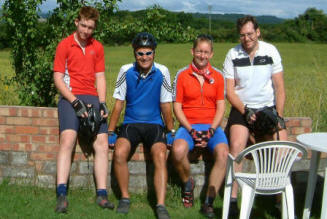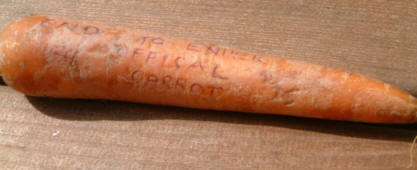Chapter 1 – In the beginning, planning & preparation
I retell our story below and add some tips from what we learnt that will hopefully help you on your trip with regard to route choice, training and bike selection
In addition to the hints and tips I provide below, Greg Venn has an excellent blog post that gives a lot of information on training and nutrition which is well worth a read. Greg is an experienced cyclist with over 82,000 miles under his wheels.
Greg also says: –
On the matter of food this is a good site, http://www.cptips.com/toc.htm#table , but too deep for the beginner I feel. Multi day rides are here http://www.cptips.com/sixrides.htm#mdr . If the reader is not a regular rider (the majority I expect) then they are going to put their untrained body through the mill, so best to go more cautious and hence my advice to eat basically all the time, little and often. The other point is to eat as soon as you stop, if you can 🙂 the body really wants to pack it away. I can see some would wait for an evening meal which is not best. Hence the advice.”
In October 2001 following a leisurely 20 Mile day long cycle pub-crawl, Mark recounted the story over a pint of his summer holiday in Scotland where his family visited John O’Groats. His then 14 year old son Tom asked why John O’Groats was so well known and next thing Mark knew, he had committed to the idea of cycling with his son on the 1000 Miles End to End “LEJOG” from Lands End to John O’Groats. Following another pint, I realised I had just committed myself to joining them all set for the summer of 2003!
The tour team consisted of myself, Keith, Mark (all “forty or thereabouts something’s” – (and that was just our waist measurement) colleagues from a previous work life), and of course Mark’s son Tom (who would have just finished his GCSE’s), whose bright idea it was in the first place. Keith had succumbed to our persuasive techniques (more beer involved), the following year after we had talked him into the merits of ditching his mountain bike for a nice sleek lightweight Italian framed racing bike. Before he new what had hit him, not only did he have a new bike, he had his summer holiday organised for 2003 as well. After all, what are friends for?!
From the outset we wanted the trip to be achievable, enjoyable and affordable so we chose our own route based on the Cycle Touring Club (CTC) Youth Hostel & Scenic Routes. The trip would take 15 days averaging around 71 miles per day, travelling as light as possible and without any support vehicle. Furthermore we quite liked the idea of travelling up the west coast of Scotland as opposed to going through Glasgow as we felt it would be quieter, more scenic and hence more enjoyable.
With route planning, make it your own is the best advice I can give. This may sound obvious but treat the challenge as a journey rather than purely just the destination, unless you are treating it as a race that is. By this I mean take your time and enjoy the journey through the country and take it as a tour and an opportunity to explore the scenic island we live on rather than as we normally do in the car, head for the nearest motorway. You’ll be pleasantly surprised by how beautiful and rural it is. My personal preference is to avoid busy Trunk roads wherever you can. They are not pleasant and dangerous. The number of times I see cyclists on the A30 in Cornwall. Why, when there is so many more safer, quieter and more scenic routes through the county that are far more enjoyable?
Consider which areas of the Country you’d like to visit, and link them together. There are plenty of resources and routes online these days to help you fill in the gaps.
Anyway, where was I ……
Keith and I had invested in £xxxx worth of fancy 27 geared Italian and American lightweight carbon fibre & aluminium engineered racing bikes (exact cost deliberately omitted in case other half’s are reading this!). Mark however was always up for a challenge and I think wanted to prove that any success would be down to “man not machine”. He paid £3 for his bike and £5 for Tom’s bike at the local Recycling Centre. Admittedly he did update it a little with Index gears and a suspension seat post.
I did a few 25-40 mile day rides during late summer of 2002 but as winter approached the bike got tucked away in the garage and seldom saw the light of day.
2003 arrived and so did the commitment to my New Year Resolution of starting my training regime. With still 7 months to go I had plenty of time to start gradually building up the fitness. In the gym a couple of times a week with the odd short bike ride thrown in when the weather allowed. Come the lighter evenings, replace the gym sessions with bike rides. Sorted …. or so I thought. Having not attempted a cycle trip of such a distance before, I thought it best to seek advice from the experts regarding recommendations, so I sent an email to the CTC for some guidance. In response, I was told I would be fine as by now with 7 months to go, at least one ride of 50 Miles each week would suffice. I decided to stick to my strategy!
With my training strategy organised, I enrolled on some Aerobiking (Spinning) sessions. This is basically an aerobics class on cycle machines. Fortunately I had been attending these classes semi regularly for a year or so, so had the knack of pacing myself and knowing what to expect. However, for anyone starting out from scratch they are extremely hard work. Keith, as a newcomer in a room full of, as he describes, ” lycra-clad techno-thump fitness freaks” tried to look “cool” as the instructor turned up the music and began a hard hour of simulated cycling sprints and climbs over mountains. “One two three, stand up two three, sit down two three, up 3 gears (more friction for simulated hill) two three, press-ups on handlebars two three” Within 10 minutes he was bright red with a hint of purple, starting to hyper-ventilate and becoming surrounded in a pool of sweat that’d been dripping off his nose and chin. By the time Donna Summer was feeling Love, Keith was feeling sick with still another 45 minutes to go!
We both stuck with it however, and with my added sessions in the gym it wasn’t long before the light evenings arrived and I was ready for some cycling on a proper bike. Distances and average speeds gradually increased until by early summer Keith and I were comfortably undertaking rides of 50-60 miles across the hills of Devon after work. Topped up with a June training weekend that covered the first 2 days of our “End to End” route through Cornwall and Devon, things were definitely looking good.
Training! My mantra in how much training to do is: “The more bike fit you are the easier you’ll find it, and hence the more you’ll enjoy it” You don’t have to be an Olympic athlete to complete the ride. Take as many days as you need and any fitness work you do before the event in preparation will help but keep it up. Better to do less but regular rather than one big session then nothing. Build up gradually and regularly and you’ll be amazed how much fitter you become and how much further you can cycle comfortably.
From what we did you can see we used the winter to try and keep fit in the gym and build up your aerobic fitness and leg strength. If you can get out on the bike as well even better. Then as you build up to the event you really can’t beat just cycling on your bike as it is by far the best preparation. Let your body get used to the saddle, legs and knees to the peddling action, and just see how your bike and you perform. Does it fit correctly for instance? Having a bike that is not sized or fitted correctly will be a recipe for disaster. (Visit a good bike shop for advice, I’ve included some links of online bike fitting resources to give you an idea of what is involved.) It isn’t just a case of making a vague adjustment on the height of your saddle!. Also don’t forget to do a training trip over a few consecutive days carrying the kit you expect to take with you to see if you’ve got the right kit. Is it too heavy, is there a problem with the panniers, have you forgotten anything, etc, so that you can get used to another full day’s cycling straight after the previous day.
What Bike? Is another question I am frequently asked. There is no real answer to this really. Any bike will do as long as it is well maintained. You don’t have to buy a specific bike to do the challenge, although you can if you wish … like I did! My thought process was buy a bike that fitted, had a good range of gears, and was light and low rolling resistance (narrow tyres as opposed to mountain bike knobblies) to minimise drag and make it less effort to peddle. I was also happy to use the bike for my general cycling afterwards therefore worth the investment. If you are intending to camp unsupported and hence have more heavy kit to carry, a racing bike is probably unsuitable as they are not designed to carry heavy loads. and a good quality touring bike or hybrid would be ideal, and perhaps a mountain bike with road tyres rather than knobblies would also be worth considering.
As you can see so many choices. So best thing to do is go down to your local friendly bike shops (more than one, shop around) and tell them what you want the bike for and your price range and let them advise you. Also don’t forget to give them an idea on how much kit your carrying as a lightweight performance roadbike would not be a good idea to pile high with heavy camping kit. It also probably won’t have anything to fix a bike rack to on the frame and possibly no mudguard lugs either – although you can get mudguards that don’t need lugs and bike racks that fit on the seat post, but they are limited by how much weight they can carry.
Anyway, I digress again ….
“Which charity are you raising money for?” This was a frequent question and with about 2 months to go I, along with the others, decided we would each raise money for our own good causes. I decided to raise money for MacMillan Cancer Relief and my local village primary school. The headmaster was very enthusiastic and invited me to talk to the children during an assembly. “Can you come dressed up in your cycle stuff and bring your bike?” Yeah why not. Next thing I know I had been talked into cycling in to the school hall to Queen’s “I Want to Ride My Bicycle”. I managed to avoid hitting any first years and spent a very enjoyable 20 Minutes telling the children all about the trip, the bike, and answering their many questions such as “Are you going to take any money with you?”
With the training well on course, the time had come to concentrate on the kit to take with us. As we were to have no support, and the lightweight racing bike approach, I very much wanted to keep the equipment to be carried the same. Lightweight travel towel, small wash kit, 1 spare change of light weight quick dry cycle clothing all crammed into a saddle and handlebar bag. Triple chain ring to cope with those steep Cornish and Scottish hills, Keith’s “Top Tip” of extra padding under the handlebar tape using draft excluder. But what about the saddle? Keith had swapped his “”no-mercy buttock cleaver” for a nice and comfy touring-type gel saddle. Should I do the same? My buttock cleaver seemed to be fine so after much indecision I decided to risk it. You will be pleased to know that this proved to be an excellent decision.
Our final decision before the start was our tour mascot. It had to be light, fairly small, streamlined and something we could be proud of. Of course a carrot inscribed with “End to End Official Carrot” fitted the bill!



